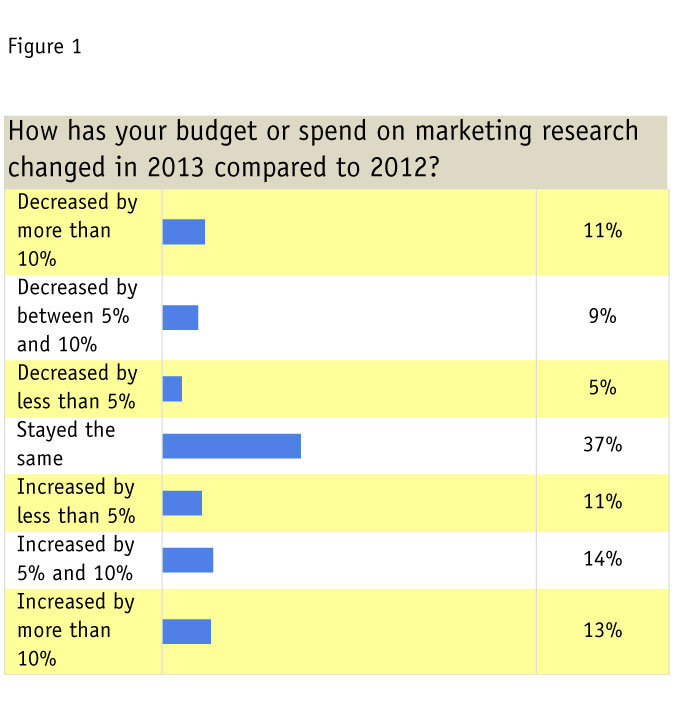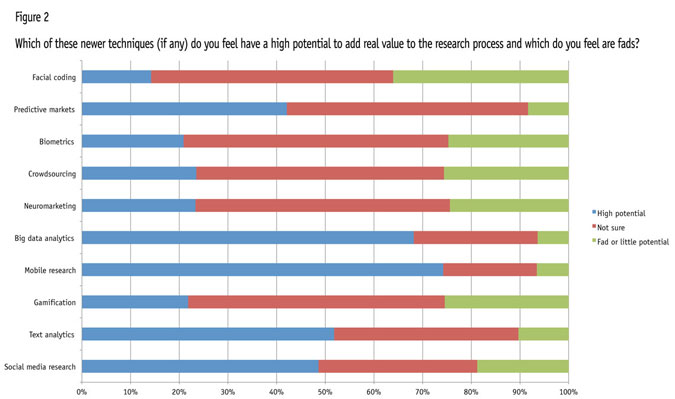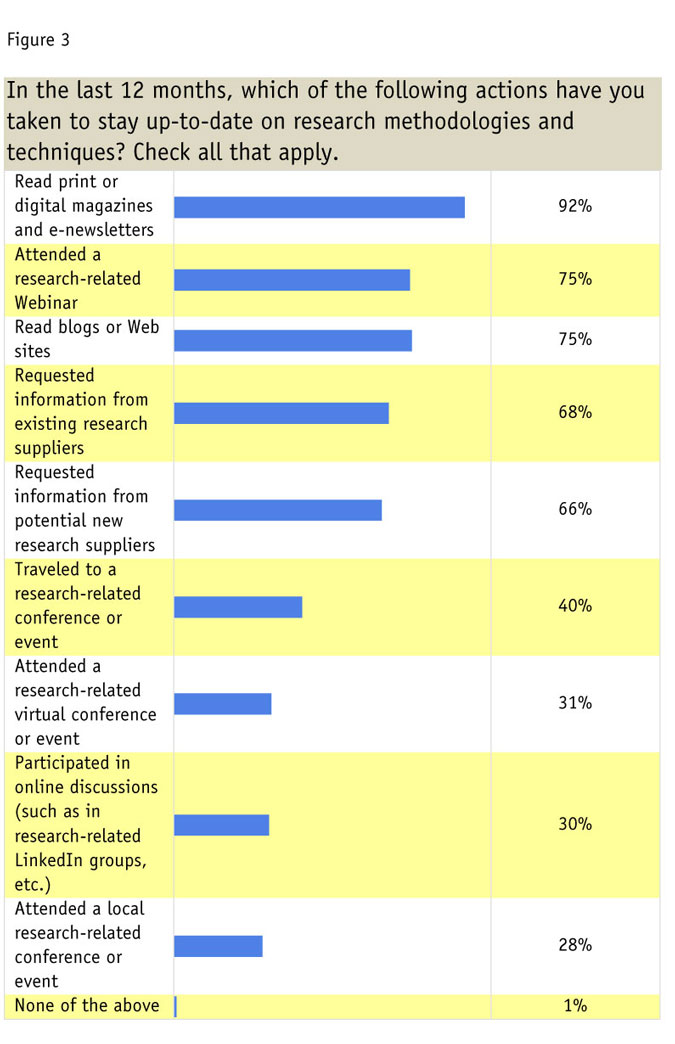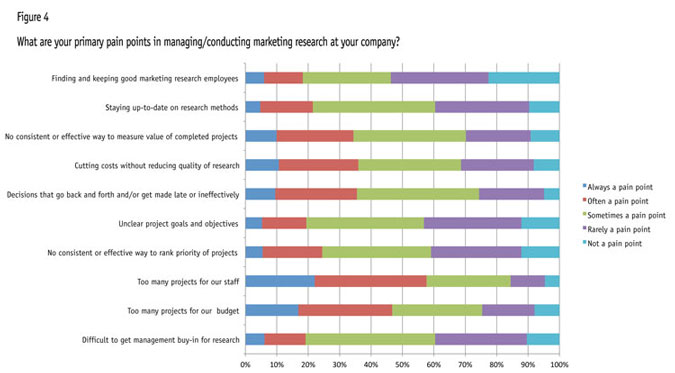Still fighting the good fight
As the editor of Quirk’s, I want to make sure that our magazine, e-newsletter and blogs are covering topics that are helpful and interesting to our readers but I also want us get to know you better. I chat with subscribers at conferences and other industry events to glean a feel for the zeitgeist but it’s also nice to draw from a larger sample to confirm some impressions and also uncover new paths down which to travel.
And now I can, thanks to the first iteration of our annual Quirk’s corporate researcher survey. One of our main goals with the study was to take the pulse of the corporate researcher, to see what’s on their minds. Questions focused on the makeup and workings of their departments; their pain points and challenges; how they assess their own performance and how others assess theirs; their preferred ways of staying up to date on the industry and its methods and their views on the value and staying power of newer research methods.
The survey was fielded with the much-appreciated support of several industry bodies, including the Marketing Research Association, the Pharmaceutical Marketing Research Group, the Marketing Research Institute International, the University of Georgia, the University of Texas Arlington’s master of science in marketing research program and the A.C. Nielsen Center for Marketing Research at the University of Wisconsin – Madison. We received 775 responses.
Leaf in the wind
Anecdotally, the picture is sometimes painted of the researcher as a leaf in the wind, being buffeted about by internal forces such as a lack of respect for the MR function, the whims of corporate politics and budget restraints. These and other issues are no doubt factors with which researchers have to contend but the responses to our survey questions paint a more hopeful picture.
On the budget front, as Figure 1 shows, while just over a third (37 percent) reported that their 2013 MR budget stayed the same as 2012’s, an almost equal number, in aggregate, reported increases, with 11 percent claiming an increase of less than 5 percent, another 14 percent claiming an increase of between 5 percent and 10 percent and a final 13 percent saying their budgets went up by more than 10 percent. In contrast, about a quarter of respondents reported a decrease in their available funds for MR.

Just over half of the respondents are in situations where there are from one to five full-time research/insights employees at their organizations, a fact reflected in the many “too much work, not enough time or budget”-type comments we received in response to one of the open-ends.
One survey question asked “How would you rate your company’s research department on the following fronts?” and, using a five-point scale of very poor to very good, the majority rated their level of influence within the company in the good to very good range; same for the ability to solve business problems using research. In response to “ability to uncover business opportunities using research” and “ability to mitigate risk for the company using research,” things were a little less sunny, with larger numbers of “fair” responses.
A companion question asked them to rate how they felt others viewed the MR department on those same aspects and while there is a disconnect between researchers’ self-assessments and those of others (more responses in the “fair” category and fewer in “very good”), the respondents seem to have a realistic (as opposed to delusional or overly-pessimistic) take on their standing with external audiences.
Similarly, when asked to assess how their departments compare to the departments at other companies, they typically rated themselves in the good to very good range on their level of influence within the company and their ability to solve business problems using research. And again, impressions leaned more toward the fair-to-good side on the topics of uncovering business opportunities and mitigating risk.
Admirably stubborn
Based on our findings, it also appears that researchers are admirably stubborn in sticking to their methodological guns in the face of the incessant calls from industry observers for them to embrace the hottest, newest techniques to avoid irrelevance. To the question “How important are the following factors when choosing which research techniques to use?” much more weight was placed on “representative sample,” “response rate” and “proven methodology” than was placed on “cutting-edge methodology.”
“Speed” and “low cost” were paramount – proof that the search for the Holy Grail of faster + cheaper endures – but “cutting-edge methodology” drew the largest number of responses in the range of “somewhat unimportant” and “neither important nor unimportant” to “somewhat important.”
Those aforementioned industry observers would likely say that these findings are proof the profession is old-fashioned and hidebound and therefore doomed but the view from here is that researchers are keenly aware that their jobs depend on delivering accurate, rigorous data and that cutting-edge techniques don’t guarantee accuracy or rigor – yet.
Indeed, data from our study shows that they are very much open to considering newer approaches and aren’t rejecting them out of hand simply because of their novelty. We asked respondents to rate the potential of a number of newer methods (Figure 2), from social media research and gamification to crowdsourcing and biometrics. Mobile research and big data analytics garnered the largest number of “high potential” votes, followed by text analytics and social media research. Facial coding, crowdsourcing and gamification drew the highest number of “fad or little potential” votes. In the main, though, the “not sure” votes won out in most cases, showing that more evidence is needed to convince those on the fence that these trendy techniques have staying power.

When it comes to staying on top of what’s new in the industry, as shown in Figure 3, researchers cited reading print or digital magazines and e-newsletters, attending research-related Webinars and reading blogs or Web sites as their top choices (multiple responses were accepted). Requesting information from existing or new suppliers was also popular. Less popular but not insignificant were attending research-related conferences or events, both in-person and virtual.

On the topic of social media as a source of information about MR, we appear to be an industry of lurkers. Many respondents said they visit research-related blogs, LinkedIn groups and Twitter on a fairly regular basis (an equally substantial number said they never followed the various social media outlets or did so less than once a month) but that’s about as far as they go: Many respondents said they never post or otherwise actively participate in social media discussions related to marketing research.
Discontent with vendors
We asked an open-end about the pain points or other challenges they experience in conducting, coordinating and managing the research process (Figure 4).

As expected, perennial problems like “too many projects, not enough time or money” and the hassles of dealing with rogue surveying by non-researchers were frequently mentioned, as they have been in other surveys we have conducted. But what jumped to the fore this time was the level of discontent with vendors. Here is a sampling of responses:
“Difficult to find quality research vendors.”
“Suppliers underdelivering ... data quality and reporting are table stakes. We need our research partners to provide insights and meaning, not just deliver a 100-slide PowerPoint.”
“Dealing with unresponsive research vendors.”
“Working with suppliers who offer actionable insights.”
“Finding reliable research suppliers who can live up to what they promote when selling their capabilities as related to the various research activities we engage in (i.e., providing useful insights, error-free data analysis and results-presentation materials).”
“Getting good quality work out of vendors. They tend to be less experienced now and frequently suggest approaches/designs that they are unable to explain or stand behind.”
Away from problems with vendors, many researchers can no doubt identify and empathize with these additional viewpoints expressed in the open-end responses:
“As an internal research agency, we are challenged with having enough bandwidth to ‘think’ for innovation, for ‘What if we looked at the data this way?’ Instead, our time is spent on just answering the objectives at hand. The benefit of being internal should be the ability to connect the dots with our business to provide the extra value. Sadly, never enough time or bandwidth to do that.”
“Nobody in the start-up/tech world understands how long traditional market research takes to conduct. With the lean start-up mentality, even a six-week turnaround is too long for most people. That being said, everyone requests research but they are too idiotic to understand how and why to do this and don’t think their requests through at all. Research gets a lot of criticism for not being aligned with our business objectives but those same antagonists will then turn around and use research in every deck.”
“Senior executive management saying too much market research is being done to make decisions, while then saying how important customer insight is to what we do (dissonance!).”
“Convincing decision makers of the importance of including ‘scientific’ research – not just a question thrown out on Facebook.”
“While I manage the budget, the dollar amounts come from marketing. When marketing runs low on funds (which they often do) we have to cut projects that are important. Not having full control of my budget is beyond frustrating.”
“Two things come to mind. Unfortunately this company does not value data; it says it does but really it doesn’t. Executives want to know why customers are doing or not doing something but we have no tools or budget to get those answers. So then they guess or do the exact same thing as last year and then panic when it doesn’t work. Secondly, the lack of budget is such a hindrance. And not that we want to spend millions on research but for a [multi]-billion-dollar company, we get $50k for the year. We are stuck doing quantitative efforts as we have software at our disposal. I have to fight to get $50 gift cards as incentives.”
Battles will endure
There were other, more positive takes from some respondents on their current situations but even among researchers in seemingly supportive organizational environments, there are battles that will likely endure:
“Market research is a well-respected group in my company. The information is used all the way up the chain to the CEO. However, there are a few areas that are challenging: 1) I work on several cross-functional teams of which market research is a big part and it’s challenging to have to explain the process to each new group of team members. 2) We outsource some of our work to vendors to help us manage the high volume of work our department has. We stay heavily involved in the project with the vendor but to some internal folks it seems like we don’t do anything and the vendor does all the work. To some we have to constantly prove our value-add to the project. 3) Not enough time to be creative in the way we present and/or collect the data.”
